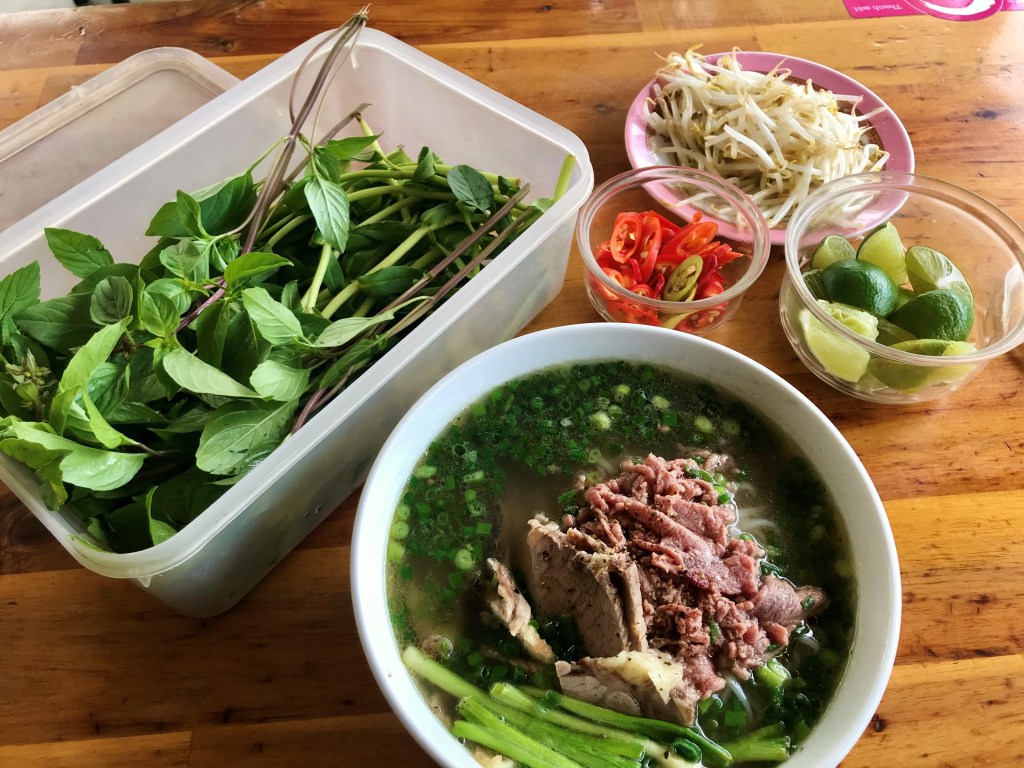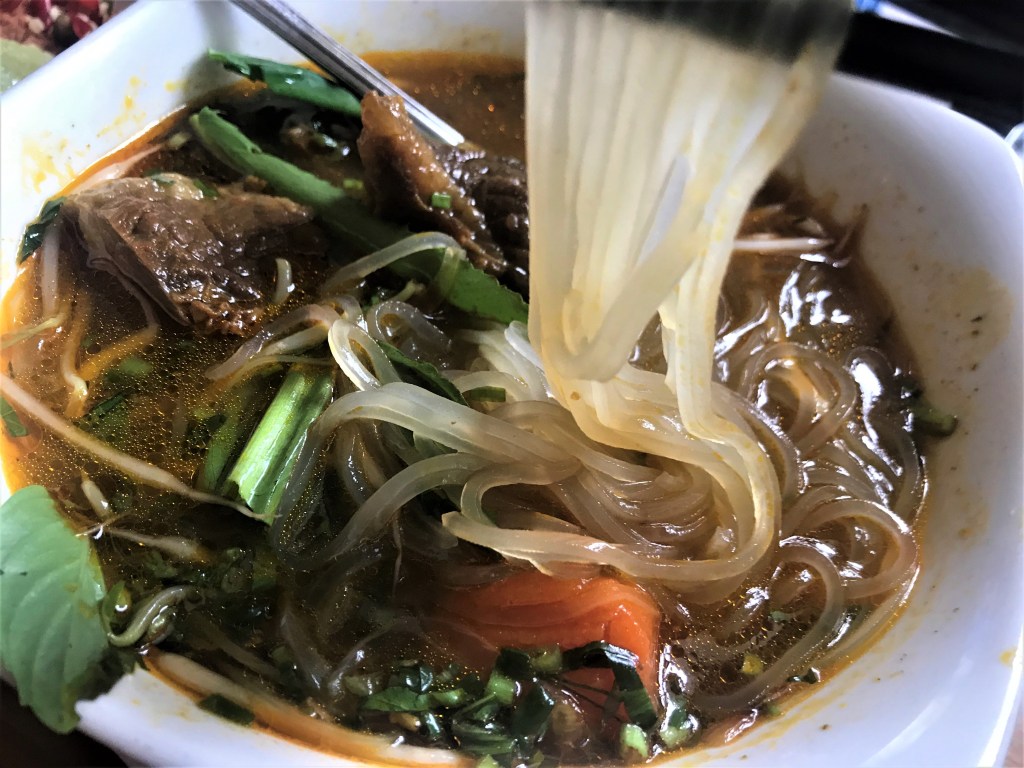
No Vietnamese food is better known than the beef-noodle soup called phở. Served everywhere in Vietnam and in restaurants around the world, phở is the ultimate comfort food. It may be found from street stalls to fine-dining restaurants, and it’s as ubiquitous in households as the tomato soup or chicken broth your mother made when you were a kid.
Long before I moved to Southeast Asia, I grew to love phở at Vietnamese restaurants in the United States. And now that I’m in Vietnam, it has become a staple of my diet. Breakfast, lunch, dinner, between meals — it doesn’t matter. Any time is the right time.
Why do I love phở? Let me count the ways. The slow-simmered broth has the savory essence of beef marrow, accented by lemongrass, ginger and coriander. The meat is sautéed just long enough to bring out its best flavor. The rice noodles add the contrasting texture that leads my palate to respond with a silent “wow!” And the herbs, spices and other botanicals complete the cornucopia of often-surprising flavors.
The preparation varies from the north of Vietnam to the south. Regional distinctions are well defined in this country, whether with regard to food, climate or business culture. In Ho Chi Minh City, for instance, the noodles are not as broad but the broth is sweeter and clearer than in Hanoi, where a fatty stock is preferred. Ironically, the best phở I’ve had in Vietnam was at Phở Nguyên, a small, open-air restaurant in the Dak Lak provincial capital of Buon Ma Thuot.

Home cooking
My friend Dung (pronounced “Yung”) grew up on Vietnam’s central coast in Dong Hoi. Her version of phở. represents a middle ground between northern and southern styles.
“It’s not easy to make a delicious phở with traditional taste,” she said. “There are many ways to cook the soup quickly and simply, but this is my recipe.
“The broth is most important. I take tubular beef bones, with marrow intact, and boil them in a pot of water for at least 45 minutes. The longer you can boil the broth, the better. Some chefs may even simmer it overnight.”
Dung said she adds spices — salt, pepper, sugar, lemongrass, ginger, coriander and chilies — early in the boiling process. Next come onions, including spring onions and shallots. She throws in a splash of nước mắm (fish sauce) toward the end.
The noodles, meanwhile, have been prepared separately. “The shop owners know the noodles that you need to cook phở,” Dung said. Usually, that means flat, freshly made rice noodles of medium width. Quickly cooked, they are placed in a bowl; the boiling broth (with meat) is poured over the top.
“I like phở with beef filet and flank,” Dung said. “I sauté the steak just rare, cut it into thin slices and add it to the pot with a squeeze of lime.”
Phở with filet and flank is called phở tái nam. With brisket, it’s phở gầu. In the south of Vietnam, you can also order it with tendons (phở gân), meatballs (phở bò viên), tripe (phở sách) or even boiled beef blood (phở tiết).
Virtually all Vietnamese soups, including phở, are served with a salad of garnishes, from greens — such as Asian basil, cilantro, mint and ngò gai (sawtooth herb) — to garlic, green onions and condiments, including chile sauce. You’re more likely to find mung bean sprouts, lime wedges and fresh sliced chile peppers in the south than the north. I like my phở with plum-based hoisin sauce and unsweetened chile sauce, but I’m still not accustomed to the sweet tương ớt chile sauce popular in Ho Chi Minh City.
Chopsticks and a deep spoon are de rigueur. Diners dip and slurp simultaneously, lifting the noodles with one hand as they scoop the broth with the other.

Different strokes
Phở is said to have originated southeast of Hanoi at the start of the 20th century. French colonists were partial to beef, which had not been especially popular in Vietnam, and Chinese workers sought to recreate a soup common in their homeland.
Previously unpopular in the South, phở suddenly became popular with the partition of Vietnam in 1954, where more than a million people fled the North. Twenty years later, in the wake of the Vietnam War, refugees brought phở to North America, Europe and Australia.
Phở is but one of many popular soups. Phở gà is made with chicken. It uses the same spices as beef, but with a broth of chicken bones, meat and some internal organs.
Bún bò Huế is another beef noodle soup, with rice noodles typically thicker and rounder than in phở. Originating from the ancient Vietnamese royal capital of Huế, on the central coast, its salt and spice are balanced by a strong flavor of lemongrass, boiled with bones and beef shank. It may be seasoned with fermented shrimp sauce, sugar and chili oil. The best bún bò includes sliced beef along with oxtail and pig’s knuckles.
Bò kho is a stew of tender braised beef, is often sold in the same street kitchens as phở. The tomato-rich broth is somewhat heavier, but it is no less delicious.
For non-meat eaters, Bún riêu is a sweet-and-sour seafood stew, made with minced crab, fish (especially catfish) or snails. It is traditionally served in a nutrient-rich tomato broth with thin vermicelli noodles.
Hủ tiếu is a noodle dish that can be served either “wet” (hủ tiếu nu’o’c, as a soup) or “dry” (hủ tiếu kho, as a salad accompanied by a side of broth). The broth is most often simmered with dried squid or shrimp, and toppings — meat and seafood, sautéed or fried — are added after (rather than during) preparation. I like this dish with yellow egg noodles instead of white rice noodles. Another delicious variation, originally from the Hoi An area of central Vietnam, is mì quảng, usually served dry.

Next: No Thanksgiving? No problem!

Is there any skiing in Vietnam?
LikeLike
Helmer, there’s actually an indoor “Snow Town” with a skating rink and a little ski slope! But no, there are no resorts in Vietnam, even in the far north.
LikeLike
Now I need a visit to Pho Viet!
LikeLike
Say hi to Tan and Tammy for me!
LikeLike
Thank you for your postings. It’s always nice to learn more about the food and culutures that make each place so unique.
LikeLike
Yum Yum!!
LikeLike